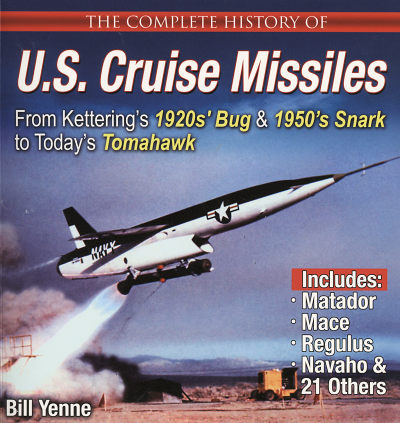Specialty Press' US
Cruise Missiles
|
Author: |
Bill Yenne |
|
Publisher |
Specialty Press |
|
Price |
$34.95 |
|
Reviewer: |
Scott Van Aken
|
|
Notes: |
204 pages, 9x9
inches, Softcover, 339 illustrations,
ISBN: 978-1-58007-256-4 |
 It is
always a delight to get a new book from Specialty Press. They seem to hit a home
run with every title they release and this one on American Cruise Missiles is
not exception. They have tackled an interesting subject and one that goes back
quite a bit farther than most of us realize.
It is
always a delight to get a new book from Specialty Press. They seem to hit a home
run with every title they release and this one on American Cruise Missiles is
not exception. They have tackled an interesting subject and one that goes back
quite a bit farther than most of us realize.
In fact, it goes back to 1917 when the Sperry
(of autopilot fame) and Curtis developed their flying bomb. This radio
controlled aircraft was nearing deployment when the war ended so it was never
used and in general, interest in flying bombs in the US went with it. To be
sure, there were still target drones, but we have to then move to Germany and
the use of the first operational cruise missile, the V-1, to continue the story.
This vehicle was reverse engineered by Republic-Ford and hundreds were were
produced. Even before that the idea of remote control flying bombs was bandied
about and developed with minimal use.
However, the seeds had been planted and the
concept developed into intermediate and intercontinental range aircraft using
current jet engines, upgraded guidance, and more powerful warheads. These craft
were quite large in order to carry sufficient fuel and the rather bulky
electronics of the day. Several of these systems reached operational capability,
albeit for a relatively short period of time as technology improved. For this we
have the Matador, Mace, and Snark for ground based systems and the Regulus for
use at sea.
Still, the legacy of the V-1 was never far
behind and it was with air launched cruise missiles that we saw the greatest
advances. The first successful one was the Hound Dog, which operated for some
ten years. Other systems were developed yet never deployed such as the Skybolt
and it was the AGM-86 ACLM that was the next step. This was all surpassed by the
Tomahawk, which could be launched from the ground, aircraft, or at sea that saw
the greatest operational use. In fact, a goodly portion of the book is devoted
to the development and a rather bewildering number of variants of this missile.
Of course, weapons development moves on and the next generation of missile is
currently under development.
The author had provided us with a fascinating
look at this weapons system, providing us with a full history not only of the
overall subject, but of each of the aircraft/missiles. This includes types that
saw limited use, or did not pass out of the prototype stage. Heavily illustrated
with some great photos and charts, this is THE book to have on the subject. It is a book that I can quite easily provide my highest
recommendation. I know you will not be disappointed.
October 2018
Review book courtesy of
 ,
where you can order your copy of this and many other superb aviation and
modeling books.
,
where you can order your copy of this and many other superb aviation and
modeling books.
If you would like your product reviewed fairly and quickly, please contact
me or see other details in the Note to
Contributors.
 It is
always a delight to get a new book from Specialty Press. They seem to hit a home
run with every title they release and this one on American Cruise Missiles is
not exception. They have tackled an interesting subject and one that goes back
quite a bit farther than most of us realize.
It is
always a delight to get a new book from Specialty Press. They seem to hit a home
run with every title they release and this one on American Cruise Missiles is
not exception. They have tackled an interesting subject and one that goes back
quite a bit farther than most of us realize.